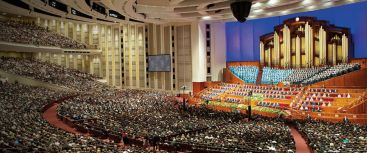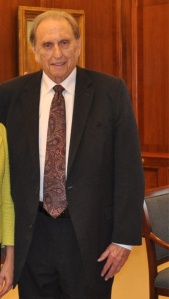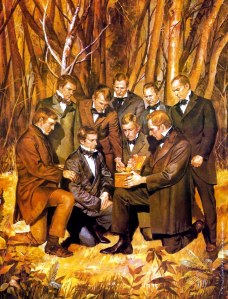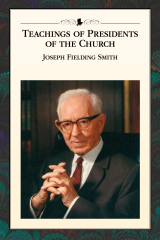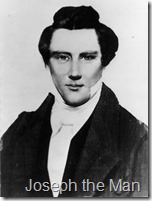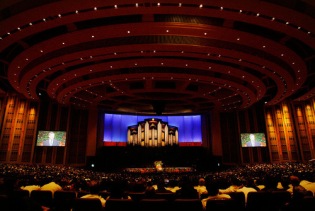
An ongoing series of articles on some common and recurring weak arguments that Christians make against Mormonism.
by Fred W. Anson
The Argument:
“There’s nothing in Mormonism that’s true – it’s all wrong and nothing but a pack of lies!”
Why It’s Weak:
As stated a number of times throughout this series, exaggeration erodes credibility and overstatement turns strong arguments into weak ones. This is an example of both: The fact of the matter is that there is some good and some truth in Mormonism despite the preponderance of errors and lies. This is just as pioneering cult researcher and lecturer Walter Martin said so well:
Within the theological structure of the cults there is considerable truth, all of which, it might be added, is drawn from biblical sources, but so diluted with human error as to be more deadly than complete falsehood.[1]
And as Bible teacher Don Basham noted, “All cults are at least 10% truth and 90% lie. If they didn’t contain some truth then no one would believe the lies – no one would join them.”[2] And I would add, based on my own experience in a cult, that if they didn’t meet some kind of a need no one would stay. So it shouldn’t surprise us to find some truth and some good in all cults – and the Mormon Church is no exception. Therefore, acknowledging what’s true and what’s good – without underestimating or discounting what isn’t – is simply a matter of common sense. And giving credit where credit is due is a matter of integrity.
1) Point One: There is some truth in the Mormon Church
Focusing exclusively on Christology, here’s what the Mormon Church gets right:
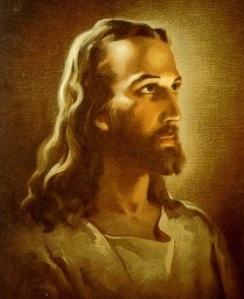 Warner Sallman, “The Head of Christ”
Warner Sallman, “The Head of Christ”
(circa 1941)
- They believe that Jesus preexisted in Heaven before becoming a man.
- They believe that Jesus is Jehovah, the God of Israel.
- They believe that we are to pray to God the Father in the name of Jesus.
- They believe that Joseph was not Jesus’ biological father.
- They believe that Jesus was the Messiah, lived a sinless life, and did the miracles reported in the Gospels
- They believe that Jesus suffered and died on a cross.
- They believe that Jesus rose physically, bodily from the grave.
- They believe that Jesus ascended bodily into Heaven.
- They believe that Jesus will return physically to the earth.[3]
2) Point Two: It’s not all wrong
It tends to get downplayed in the heat of battle but in the area of values, morality, and social issues, the Mormon Church is spot on in a number of areas. Mormon Researcher Eric Johnson, an Evangelical Christian who is generally critical of Mormonism, has gone so far as to identify ten areas (in David Letterman countdown fashion) that the LdS Church excels at and that he believes we can learn from:
10. Dedication to the heritage and the faith.
From a young age, Mormon children are taught about their heritage and the struggles that the early LDS pioneers faced when it came to living their faith. On the other hand, most of us Bible-believing Christians have very little knowledge of our history, including the conflicts and persecutions of the early Christian church. As a result, we do not benefit from the examples of our own past…9. Overall morality.
While Mormons struggle with sin just like everyone else, they are generally well known for keeping a high moral codes and abstaining from a secular lifestyle. Faithful members are not to partake in drugs, alcohol, or tobacco. Remaining chaste, personal modesty, and being honest (along with the other commandments) are important virtues in the LDS lifestyle…8. Politics and religion mix.
The Mormon Church is willing to put its money where its mouth is when political issues warrant a moral response. Certainly not every member may like the conservative stance that the LDS Church takes. But it is admirable how the Church is willing to support those things it strongly believes in…7. Organization in its leadership.
The LDS Church is a well-oiled machine when it comes to organization, from the top down to the bottom…6. Positive peer pressure towards missions.
Many Mormon young people look with anticipation for the day when they can leave on a church mission… Wouldn’t it be wonderful if every Christian young person were encouraged to spend two years of his or her life on the mission field? Perhaps many more career missionaries would be a result if short-term missions became a Christian priority…5. Respecting Sundays as sacred.
Sundays in the Mormon Church are treated as a quiet day, a time to reflect and be with the family after attending the morning service at the local ward. Recreational and sporting activities as well as retail excursions are discouraged… We should not forget that the day of rest was created for the benefit of man…4. Religious education for the youth.
The LDS Church is very concerned about educating its young people in the ways of its faith… Later, when the college years come and the young adult is challenged in his faith, he will have some possible answers to help him remain faithful to his religion…3. Helping to supply the needs of the membership.
Mormons are known for being generous, even going out of their way to help their fellow members…2. Preventing members from falling through the cracks.
When a Mormon fails to attend the services of his designated local ward for several weeks, he is sure to be missed… While I am not suggesting that Christian churches should become legalistic nags in order to force its membership to attend meetings and volunteer for projects, perhaps the general idea of following up on those who all of a sudden are no longer there would fulfill the shepherd role that the church is supposed to have…1. The importance of families.
And the number-one thing we can learn from the Mormons is (drum roll, please) the priority the Mormon Church places on family life. Certainly many Christian families are very successful. Yet few churches emphasize the importance of the family like the Mormons do; they even set aside every Monday evening for Family Home Evenings to play games, talk, do devotions, etc…[4]
And Mr. Johnson isn’t alone, Christian Commentator Nick Asolas has developed his own list:
The Church Office Building of the Church of Jesus Christ of Latter-day Saints
1. Public Relations
If Christianity had a PR firm, it should have been fired decades ago. The fact that we don’t is so painfully obvious that preaching against our past failures has almost replaced the Gospel itself…2. Staffing Issues
In the average Christian church, the largest budget section is the salary of the staff. We have managed to take a couple curious verses in the New Testament and turn them into a mandate for creating medium-sized corporations complete with corporate perks and parking spaces. I am not going to make a case against paid staff in this post, but it is possible…3. Engaging the Community
I think this is because as church leaders, we know what we need to do (talk to our neighbors, etc) but we don’t know how to do it. The Mormons are great at this. Granted, their strategy is simple and hasn’t changed for decades, but they have conditioned their community now to know who they are and what they are about based on looks alone…4. Social Media
The LDS Church is excellent at talking with people across their social media sites. There are several Facebook pages for the different sections and interests and multiple Twitter feeds users can follow for church news, devotions etc. The official LDS Facebook page is updated daily with videos, polls and conversations and has almost half a million users…5. Unity
This is the biggest and most important. While there are varying sects of the LDS religion, for the most part, they are one unified body that offers a consistent experience across all regions and wards. The statement of faith for all communities is the exact same and there is no competition among branches…[5]
Now I have been extremely critical of Greg Stier the president and founder of “Dare 2 Share” in the past for his uncritical and discernment impaired “Mormon Envy” of Mormon youth programs[6] but I will acknowledge that in pointing to the finer aspects of those programs he made some good points, including this one:
We need to push our teens. We need to turn them into active activists. We need to build consistent opportunities for service, outreach and training. We need to equip them to share their faith and then go with them, leading the way. After all, we are youth leaders.[7]
And Methodist minister and youth ministry expert Kenda Creasy Dean agrees. In her book “Almost Christian: What the Faith of Our Teenagers is Telling the American Church” she devotes the entire third chapter (entitled “Mormon Envy: Sociological Tools for a Consequential Faith”) to deconstructing and analyzing the Mormon youth enculturation process. In the end she concludes:
By intentionally reinforcing the significance of Mormonism’s particular God-story, by immersing young people in a community of belonging, by preparing them for a vocation and by modeling a forward-looking hope, Mormons intentionally and consistently create the conditions for consequential faith—so much so that Mormon teenagers are more likely than teenagers from any other group to fall in the category of young people the NSYR [National Studies of Youth and Religion] called highly devoted.[8]
In addition to everything that been said above, I would add my own “Mormon Envy” item to the list: Community. It was hinted at in the lists above but I would like to state it plainly: The LdS Church does a great job of creating a faith-based community of belonging that meets members social needs. Further, Mormon culture includes an element that’s missing from far too many of our churches: Good clean, fun. To be exact, they have fun for fun’s sake and nothing else.
When I was a kid I used to secretly hope that my parents would convert to Mormonism because the social events at the Ward Halls of Mormon friends and family members were always so darn fun! My Mormon cousins did Boy Scouting and they regularly had awesome, memory building, family outings. On the other hand my dreary, church meeting addicted, Nazarene parents seemed to think that fun was a sin and boredom a virtue. Their church’s idea of “fun” in my mind was, “Hey, I’ve got it! Let’s have another revival/potluck/prayer/testimony meeting!” Now you boring old religious people might love those things but they’re not exactly a good memory building, family bonding, experience if you’re a kid who’s still undecided about this whole Christianity thing – sorry folks, but there it is!
Even today, decades later, I have to ask: Why are so many of our churches so darn boring? Why can’t we just have some good clean fun every once in a while? Why can’t we just get together and have a good time? Why does everything have to be some form of religious utilitarianism? I’m sorry fellow mainstream Biblical Christians but on the community thing, in comparison to the Mormon Church, we’re losing badly. This is an area where we can do a lot better in my opinion. I mean, come on, in the Old Testament God commanded the Jews to have seven festivals per year.[9] Yes, that’s right He commanded them! And since God seems to love a party shouldn’t we, His covenant people, love them too?
In fact, I’ve found that the rich community of Mormonism is the one thing that will keep members in the LdS Church long after they stopped believing in Joseph Smith, Mormon doctrine, or even God. Mormon culture is so rich and need fulfilling that it can be hard to leave when you’ve decided that its beliefs are hooey. If we did better in this area we would probably see far more Mormons leave the LdS Church and far less transition into atheism when they do.
The bottom line is this: The Church of Jesus Christ of Latter-day Saints doesn’t get everything wrong and they get quite a few things right. In fact, in terms of operations, maintaining a family first philosophy, very intentionally and deliberately engaging the surrounding cultural, creating a community of purpose and belonging, and caring for their membership they do some things better than many mainstream Christian churches do.
3) Point Three: It’s not all lies
Well now, okay, okay, okay, yes, there is a lot of deceit that goes on in the LdS Church! I’ve said it, I feel better now. Most egregious of all is how it chronically, even habitually, lies to its own members. Never-the-less, as stated above, since it still contains at least 10% truth, there is some truth in Mormonism.
Further, Mormon Leaders don’t lie all the time. And official church literature doesn’t lie all the time – but when you do lie they do “go big!” So the problem that I have with the “it’s nothing but a pack of lies!” portion of the weak argument isn’t that it’s not more true than false but that it’s hyperbole.
The Stronger Arguments:
Building a stronger argument in this area involves two things: 1) Not engaging in over-the-top hyperbolic rhetoric, and; 2) Presenting your argument in a way that’s fair and balanced rather than obviously biased.
First Suggested Strong Argument: Present a balanced rather than biased argument
To illustrate how one does this, let’s consider the list of things that Mormonism gets right in the Christology that was presented above. Rather than arguing that, “There’s nothing in Mormon Christology that’s true!” (which is so extreme that it’s like announcing, “I’m biased, my mind is closed, and I’m unwilling to consider the full body of evidence!”) a more balanced argument would look something like this:
 Unknown Artist, “Mormon Corporate Jesus”
Unknown Artist, “Mormon Corporate Jesus”
“Well the LdS Church does get some things right in it’s Christology – including the two most important things, His divinity and His bodily resurrection from the dead. However, it also gets far more wrong, specifically:
- Jesus is one of billions of spirits who preexisted in Heaven before becoming human.
- Jesus is one of three Gods ruling the universe (among other Gods that also exist).
- We are never supposed to pray directly to Jesus.
- God is Jesus’ “literal” father in the flesh—compromising the truth that Mary was a virgin.
- Some of Jesus’ statements must be revised according to Joseph Smith’s revelations.
- Jesus accomplished the Atonement primarily in the garden of Gethsemane.
- Jesus by his resurrection assures immortality in some heavenly kingdom for virtually everyone.
- Jesus returned to the earth to preach to the Nephites and start a separate church for them.
- Jesus appeared to Joseph Smith, condemned all existing churches, and restored the true church.[10]
Unfortunately, due to what it gets wrong, the Mormon Jesus isn’t the Christ of the bible – he is the type of ‘another Jesus’ that Paul warned us against in 2 Corinthians 11:4.”
Second Suggested Strong Argument: Present both sides of the coin
Closely aligned with the first strong argument is simply giving both sides of the coin. For example, even though the last section presented only the positive side of the coin, an argument regarding the both sides of the LdS Church’s Mormon Missionary program coin might look like this:
“Christian Youth Ministry experts like Greg Stier and Kenda Creasy Dean have praised your missionary program. Even Eric Johnson, who’s a critic of the Mormon Church, has said that it creates ‘positive peer pressure’ within your youth groups and culture. However, it has a dark side too, specifically:
 It has created a culture whereby fear of their family’s reaction puts pressure on disenchanted LDS Missionaries to continue with their missions whether they want to or not. [click here for supporting evidence]
It has created a culture whereby fear of their family’s reaction puts pressure on disenchanted LDS Missionaries to continue with their missions whether they want to or not. [click here for supporting evidence]- LDS Church Missionary training and policies employ Mind Control techniques and tactics.
- The LDS Church focuses on the needs and interests of the institution over the needs and interests of the members. For example, on January 29, 2013, the LDS Church announced that the Benemerito De Las Americas private school in Mexico would be closed and converted into a Missionary Training Center leaving its more than 2,000 LDS students to the mercy of the vastly inferior Mexican public education system.[11]
So while I and other Christians applaud the good impact that your missionary programs have on Mormon young people, at the same time we often wonder if they and others get hurt more often than they get helped by it. After all, isn’t 18-years old awfully young to be taking on a role in life that requires some degree of maturity and life experience? Sometimes I wonder if the price for being a Mormon Missionary is simply too high.”
Another example might go like this:
“One thing that I love about the LdS Church is how it does such a great job of creating a faith-based community of belonging that meets member social needs. As kid I loved how you all know how to have good clean fun for fun’s sake and nothing else. I mean, for goodness sake, even after they’ve left Ex-Mormons still try to find ways to stay engage in Mormon Culture – that says something!
However, what seems to be missing from LdS community is real authenticity and vulnerability. The community relations are social but not intimate. The perfectionist expectations create a culture of “looking good” – where you don’t admit that you aren’t measuring up or that you are struggling in some way. As former Mormon composer J.A.C. Redford once said, “You get a casserole if you’re sick, but not if you’re doubting.” To be sure, evangelical churches can suffer from the same problem, but from what I’ve seen in the LdS Church it’s both extreme and chronic. Candidly, I think if I’d had to deal with my drug and alcohol addictions as a Mormon I’d still secretly be drunk and using! Have you ever thought about any of this?”
And you can trust me when I say this: They probably have. I know this because I’ve had Mormons talk to me about this when we were in private and they feel safe enough to open up. They can’t talk about this stuff to insiders but they will to outsiders that they feel safe with.
Third Suggested Strong Argument: “So what?”
Now I would imagine that some Mormons reading this article might be tempted to point to the positive things that have been said in this article and crow, “This only proves that we are indeed the only true and living Church!” This isn’t speculation, Mormon are prone to use the good works and positive aspects of their institution as proof of its veracity. How many times have we heard a Latter-day Saint say, “Just inspect the fruit – it’s good!” as evidence of the truthfulness of Mormonism? However, as thesis #70 of the 95 LDS Theses points out:
70. It [the LdS Church] publicly (and loudly) trumpets its philanthropic work, when compared to other churches its per capita outlay is less than what smaller, less wealthy, less organized religious organizations spend: “A study co-written by Cragun and recently published in Free Inquiry estimates that the Mormon Church donates only about 0.7 percent of its annual income to charity; the United Methodist Church gives about 29 percent.”
(Caroline Winter, “How The Mormons Make Money”, Business Week; July 18, 2012) [click here for supplemental evidence]
In the end, this argument proves nothing – it’s just a bad argument. There are a lot of groups that not only do good works but do far more of it than the LdS Church both per capita and in total. To cite one example, let’s talk about WalMart which in 2012 gave 1.7% of its pre-tax profits to charity.[12] Does that make WalMart the only true and living store?
Further, there are many other groups getting similar positive results from their members and in their communities. And this isn’t limited to religious groups, we could point to groups like the Red Cross, the United Way, the Shriners, the Kiwanis, Alcoholics Anonymous, and other institutions that give and do far more than the LdS Church does. And in terms of religious groups the Roman Catholic Church absolutely buries the LdS Church in terms of giving, good works – and some would add, demonstrably positive outcomes – with its membership. So I guess the Roman Catholic Church is really the only true and living church, right?
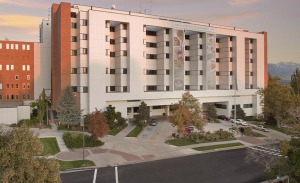 LDS Hospital, Salt Lake City, which was sold off to Intermountain Healthcare in 1975. The Mormon Church now owns no hospitals. period.
LDS Hospital, Salt Lake City, which was sold off to Intermountain Healthcare in 1975. The Mormon Church now owns no hospitals. period.
Finally, whenever, a Mormon uses this argument with me I always ask this question: “Where are the Mormon Church owned hospitals and orphanages?” Between where I live and work (a 51-mile stretch) there are seven Catholic hospitals and several Catholic orphanages. And I haven’t even added in the hospitals and orphanages that are owned by Protestant churches in the same area. So how many Mormon equivalents are there? Answer: Zero. The LdS Church doesn’t even have any church owned hospitals – it sold them all off years ago.[13] And while the Mormon Church offers adoption as part of its family services portfolio it doesn’t own a single orphanage and has even outsourced its adoption agency.[14] In this area the LdS Church is conspicuous in its absence. Thus, its “good works” bravado is most certainly more heat than light – while it may sound good at first, it simply doesn’t hold up under scrutiny.
Finally, always remember the Golden Rule of Apologetics
The Golden Rule of Apologetics is:[15]
“Always treat your debating opponent’s evidence and arguments the way that you would want to have your evidence and arguments treated“
All too often I see Christians engaging in the exact opposite of this, in something that apologists call “Scorched Earth Tactics”. This is a tactic whereby one is determined to win the debate no matter what the cost. It’s like dropping napalm or salting the ground after each advance so nothing can grow in your wake. The end result is that all too often you win the debate but lose your debating opponent – forever.
This is a formula for failure since it can take Mormon years, even decades to shake off the mind control of the LdS Church, to unsnap psychologically, and to start considering the body of evidence through clear eyes rather than Mormon sunglasses. And then there are typically several years more after that before they transition out due to family, professional, and cultural entanglements. Therefore, it’s always best to strive to maintain a good relationship even if you’re at loggerheads as debating opponents. Think long, not short term, and always, always, always consider how to maintain the relationship without compromising your message or yourself.
That sounds so easy doesn’t it? It’s not. It can be so hard to keep one’s passions, ego, and pride in check when engaging Mormons. And if you really like the person it can be hard not to soften your message to maintain the relationship. It’s a balancing act. Which is why we so desperately need the mind of Christ and the power of the Holy Spirit guiding us rather than our fallen human nature. So for those moments when you feel your adrenaline beginning to pump, your palms beginning to sweat, and your eyes beginning to bulge I would encourage you to remember (or better yet, memorize) what God has said to us through His word:
Opponents must be gently instructed, in the hope that God will grant them repentance leading them to a knowledge of the truth,
(2 Timothy 2:25 NIV)Let your conversation be always full of grace, seasoned with salt, so that you may know how to answer everyone.
(Colossians 4:6 NIV)But in your hearts revere Christ as Lord. Always be prepared to give an answer to everyone who asks you to give the reason for the hope that you have. But do this with gentleness and respect,
(1 Peter 3:15 NIV)
For as my wiser older sister once said so well, “The church is a mess and always has been. If it wasn’t for Jesus none of us would be Christians!” And that’s the best news of all – nothing depends entirely on you or me!
Summary and Conclusion:
Again, exaggeration erodes credibility and overstatement turns strong arguments into weak ones. The weak argument as presented here is an example of both. As I have shown here there is some good and some truth in Mormonism despite the mountain of lies and errors in the LdS Church. There is not only no shame in giving credit where credit is due, but doing so builds credibility. And not only do fair, full arguments demonstrate integrity, they also build trust so that honest relationships can form. And above all they demonstrate that you’re committed to the truth above all else.
Do these things and your arguments will always be strong and have impact. It’s all about balance.
 “Truth without love is too hard. Love without truth is too soft”
“Truth without love is too hard. Love without truth is too soft”
— Jim Spencer, Idaho Pastor and former Mormon
NOTES
[1] Walter Martin, “The Kingdom of the Cults”, p.24
[2] Don Basham, “Spiritual Warfare”, lecture at Santa Ana High School 1980, taken from author’s personal notes from the event.
[3] Adapted from Rob Bowman, “The Mormon View of Jesus Christ”, Institute for Religious Research website. I would encourage the reader to read this article in its entirety as it also discusses in full detail how Mormon Christology is both right and wrong in each of these areas.
[4] Abridged from Eric Johnson, “10 Things Christians Can Learn from the Mormons”, Mormon Research Ministry website. Again, I would encourage the reader to read this article in its entirety as it also discusses the LdS Church’s imbalances and flaws in regard to each of these items.
[5] Abridged from Nick Asolas, “5 Things We Need to Learn from the Mormon Church”, Shrink The Church website.
[6] See “An Open Letter to Greg Stier”
[7] Greg Stier, “Why Mormons Do Better Youth Ministry Than We Do”, Christian Post website.
[8] Kenda Creasy Dean, “Almost Christian: What the Faith of Our Teenagers is Telling the American Church” (p. 50, Kindle position 881). Oxford University Press. Kindle Edition.
[9] See “What are the different Jewish festivals in the Bible?”, GotQuestions.org website
[10] Op cit, Rob Bowman.
[11] These three points were taken from “The 95 LDS Theses”. They are theses #30, #75 and #2 respectively.
[12] Sarah Frostenson and Megan O’Neil, “10 Companies That Gave the Most Cash in 2013”, The Chronicles of Philanthropy website.
[13] See the “Hospitals” article in the “The Encyclopedia of Mormonism”. BYU Harold B. Lee Library website.
[14] From the LdS Church’s “Adoption Services” website:
Current Services Offered by LDS Family Services
We have made changes to the way we provide services to single expectant parents and prospective adoptive families. As of August 1, 2014, we no longer function as a full-service adoption agency and instead outsource most adoption functions. However, we continue to provide consultation for adoptive couples, screening and registration on an adoption matching website, and counseling for single expectant parents.
(retrieved January 7, 2015)
[15] For a more thorough analysis and explanation of “The Golden Rule of Apologetics” see Kenneth R. Samples‘ seven part series on the subject which starts here, “The Golden Rule of Apologetics Part 1”.




